36 | Transport in Vascular Plants
A Whole Lot of Shaking Going On
(True) - Plants have various adaptations that aid in the acquisition of resources, including water, minerals, carbon dioxide, and light. For example, aspen leaves tremble in light wind, why?
(True) - The success of plants depends on their ability to gather resources from their environment and transport them to where they are needed.
Concept 36.1 Adaptations for Acquiring Resources Were Key Steps in the Evolution of Vascular Plants
(True) - The algal ancestors of land plants absorbed water, minerals, and CO2 directly from the surrounding water.
(True) - Early nonvascular land plants lived in shallow water and had aerial shoots.
Natural Selection - What phenomena favored taller plants with flat appendages, multicellular branching roots, and efficient transport?
(True) - The evolution of xylem and phloem in land plants made possible the long-distance transport of water, minerals, and products of photosynthesis.
Xylem - Transports water and minerals from roots to shoots.
Phloem - Transports photosynthetic products from where they are made to where they are needed.
Shoot Architecture and Light Capture
Stems - They serve as conduits for water and nutrients and as supporting structures for leaves.
Light Capture - Shoot length and branching pattern affect, what?
(True) - There is a trade-off between growing tall and branching. The more energy invested into branching, the less energy available for growth in height; and vice-versa.
(True) - There is a positive correlation between water availability and leaf size.
Phyllotaxy - The arrangement of leaves on a stem is a species-specific trait important for light capture.
Alternate - Most angiosperms have _ phyllotaxy with leaves arranged in a spiral.
(True) - Angiosperms with alternate phyllotaxy have angles of 137.5 degrees and likely minimizes shading over lower leaves.
(True) - The total area of the leafy portions of all the plants in a community affects the productivity of each plant.
Self-Pruning - The shedding of lower shaded leaves occurs when they respire more than they photosynthesize.
Leaf Area Index - This affects light absorption. It is the ratio of total upper leaf surface of a plant divided by the surface area of land on which it grows.
7 - A Leaf Area Index higher than _ results in shading to the point that self-pruning occurs.
Leaf Orientation - It affects light absorption. In low-light conditions, horizontal leaves capture more sunlight. In sunny conditions vertical leaves are less damaged by sun and allow light to reach lower leaves.
The Photosynthesis-Water Loss Compromise
Stomatal Pores - These are necessary to allow diffusion of CO2 into the photosynthetic tissues of leaves.
(True) - Over 90% of the water lost by plants is by evaporation from stomatal pores a.k.a Stomatal Transpiration.
Shoot Adaptations - Vascular plant adaptation that represents compromises between enhancing photosynthesis and minimizing water loss.
Root Architecture and Acquisition of Water and Minerals
(True) - Soil contains resources mined by the root system.
(True) - Root growth can adjust to local conditions. Example, roots branch extensively into pockets of high nitrate availability and grow straight through pockets of low nitrate availability.
(True) - Roots are less competitive with other roots from the same plant, than with roots of different plants.
Mycorrhizae - Roots and the hyphae of soil fungi form mutualistic associations, called?
Mycorrhizal Fungi - These fungi increase the surface area for absorbing water and minerals, especially phosphate.
(True) - Mutualisms with fungi helped plants colonize land.
Concept 36.2: Different Mechanisms Transport Substances Over Short or Long Distances
Apoplast & Symplast - What are the two major transport pathways through plants?
The Apoplast and Symplast: Transport Continuums
Apoplast - Consists of everything external to the plasma membrane. It includes cell walls, extracellular spaces, and the interior of dead cells such as vessel elements and tracheids.
Symplast - Consists of the cytosol of all the living cells in a plant, as well as the plasmodesmata.
Apoplastic Route, Symplastic Route, Transmembrane Route - What are the three transport routes for water and solutes?
Apoplastic Route - Route through cell walls and extracellular spaces.
Symplastic Route - Route where water and solutes cross a plasma membrane once and then travel through the cytosol.
Transmembrane Route - Route where water and solutes repeatedly cross plasma membranes as they pass from cell to cell.
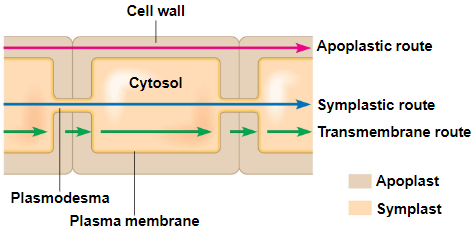
Short-Distance Transport of Solutes Across Plasma Membranes
(True) - Plasma membrane permeability controls short-distance movement of substances.
(True) - Both active and passive transport occur in plants.
H+ - In plants, membrane potential is established through pumping __ by proton pumps.
Na+ - In animals, membrane potential is established through pumping __ by sodium-potassium pumps.
(True) - Plant cells use the energy of H+ gradients and membrane potential to cotransport other solutes by active transport.
(True) - Plant cell membranes have ion channels that allow only certain ions to pass.
Short-Distance Transport of Water Across Plasma Membranes
Osmosis - The diffusion of water into or out of a cell that is affected by solute concentration and pressure.
Water Potential - A quantity that includes the effects of solute concentration and physical pressure.
(True) - Water potential determines the direction of movement of water. Water flows from regions of higher water potential to regions of lower water potential.
Potential - It refers to water’s capacity to perform work.
Ψ - What symbol abbreviates water potential?
Megapascal (MPa) - Water is abbreviated by Ψ and measured in a unit of pressure, called?
Ψ=0 - MPa for pure water at sea level and at room temperature.
How Solutes and Pressure Affect Water Potential
Solute Concentration, Pressure - These two factors affect water potential in plants.
Ψ = ΨS + ΨP - What is the equation for water potential?
Molarity - The solute potential (ΨS) of a solution is directly proportional to its?
Osmotic Potential - Solute potential is also called?
Pressure potential (ΨP) - is the physical pressure on a solution.
(True) - Pressure potential can be positive or negative.
(True) - Solution withdrawn by a syringe is under negative pressure. It is under positive pressure when it is being expelled by the syringe.
Turgor Pressure - It is the positive pressure exerted by the plasma membrane against the cell wall and the cell wall against the protoplast.
(True) - Turgor Pressure = Flaccid, Turgid, Plasmolysis
(True) - Osmosis = Hypertonic, Isotonic, Hypotonic
Protoplast - It is the living part of the cell, which also includes the plasma membrane.
Water Movement Across Plant Cell Membranes
(True) - Water potential affects uptake and loss of water by plant cells.
Flaccid (Limp) - The state of a cell placed in an environment with a higher solution concentration. It loses water and undergoes plasmolysis.
Plasmolysis - Occurs when the protoplast shrinks and pulls away from the cell wall.
Turgid - If the flaccid cell is placed in a solution with lower solute concentration, it gains water and becomes?
Turgor Loss - loss in plants causes wilting, which can be reversed when the plant is watered.
Aquaporins: Facilitating Diffusion of Water
Aquaporins - Transport proteins in the cell membrane that facilitate the passage of water.
(True) - The opening and closing of aquaporins affect the rate of osmotic water movement across the membrane.
Long-Distance Transport: The Role of Bulk Flow
Bulk Flow - It is the movement of a fluid driven by a pressure gradient. Efficient long-distance transportation of fluid requires this.
(True) - Water and solutes move together through tracheids and vessel elements of xylem and sieve-tube elements of phloem.
(True) - The branching veins in leaves ensure that all cells are within a few cells of the vascular tissue.
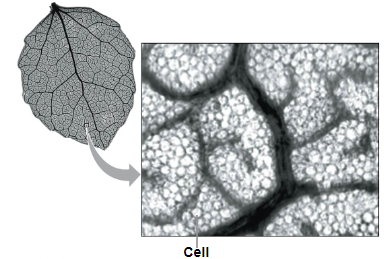 (True) - Bulk flow is enhanced by the structural adaptations of xylem and phloem cells. Mature tracheids and vessel elements have no cytoplasm, while sieve-tube elements have few organelles in the cytoplasm.
(True) - Bulk flow is enhanced by the structural adaptations of xylem and phloem cells. Mature tracheids and vessel elements have no cytoplasm, while sieve-tube elements have few organelles in the cytoplasm.
(True) - Bulk flow is enhanced by the structural adaptations of xylem and phloem cells. Perforation plates connect vessel elements and porous sieve plates connect sieve-tube elements.
Diffusion, Active Transport, Bulk Flow - These cellular phenomena act together to transport resources throughout the plant (3).
Concept 36.3: Transpiration Drives the Transport of Water and Minerals from Roots to Shoots Via the Xylem
(True) - Plants move large volumes of water from their roots to shoots everyday.
Absorption of Water and Minerals by Root Cells
Root Tips - Where do most water and mineral absorption occur? It is also where root hairs are located and the epidermis is permeable to water.
Root Hairs - They account for much of the surface area of roots.
Cortical Cell Membranes - These enhance the uptake of water and selected minerals after soil solution enters the roots.
(True) - Active transport enables essential minerals to accumulate at much higher concentrations in roots compared to the surrounding soil.
Transport of Water and Minerals into the Xylem
Endodermis - The innermost layer of cells in the root cortex
Endodermis - It surrounds the vascular cylinder and is the last checkpoint for selective passage of minerals from the cortex into the vascular tissue.
(True) - Water can cross the cortex via the symplast or apoplast.
Casparian Strip - A waxy part of the endodermal wall which blocks the apoplastic transfer of minerals from the cortex to the vascular cylinder.
Plasma Membrane of Endodermal Wall - Where must water and minerals cross within the endodermal wall to enter the vascular cylinder?
Endodermis - Again, this regulates and transports the needed minerals from the soil into the xylem.(True) - Endodermal cells discharge water and minerals from their protoplasts into their own cell walls.
(True) - Diffusion and active transport are involved in the movement from symplast to apoplast.
(True) - Once in the apoplast, water and minerals can enter the tracheids and vessel elements.
Bulk Flow Transport Via the Xylem
Xylem Sap - It is made up of water and dissolved minerals, which is transported from roots to leaves by bulk flow.
Transpiration - The transportation of xylem saps involves this.
(True) - Transpiration is the evaporation of water from a plant’s surface.
(True) - Transpired water is replaced as water travels up from the roots.
Is sap pushed up from the roots or pulled up by the leaves?
Pushing Xylem Sap: Root Pressure
(True) - At night, root cells still continue to pump mineral ions into the xylem of the vascular cylinder. This lowers water potential.
Root Pressure - This is generated when water flows in from the root cortex. It’s basically a push of xylem sap.
Guttation - It’s the exudation of water droplets on tips or edges of leaves. Root pressure sometimes results with this.
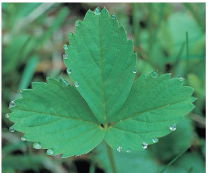 (True) - Positive root pressure is relatively weak and it is only a minor mechanism of xylem bulk flow.
(True) - Positive root pressure is relatively weak and it is only a minor mechanism of xylem bulk flow.
Pulling Xylem Sap: The Cohesion-Tension Hypothesis
Cohesion-Tension Hypothesis - A hypothesis claiming that transpiration and water cohesion pull water from shoots root.
(True) - In the Cohesion-Tension Hypothesis, Xylem sap is normally under negative pressure.
Transpirational Pull
(True) - Water vapor in the air spaces of a leaf diffuses down its water potential gradient and exits the leaf via stomata.
Mesophyll Cell Walls - As water evaporates, the air-water interface retreats into where?
(True) - The surface tension of water at the air-water interface creates a negative pressure potential.
(True) - Negative pressure potential lowers water potential.
Negative Pressure Potential - Created at the air-water interface, it pulls water molecules from more hydrated areas of the leaf.
(True) - The cohesion of water molecules transfers the pulling forces to the water in the xylem.
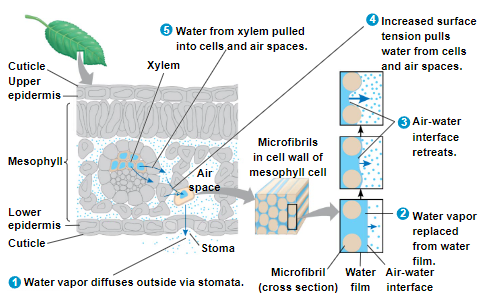 Watch vids on transpirational pull.
Watch vids on transpirational pull.
(True) - The transpirational pull on xylem sap is transmitted from leaves to roots.
Cohesion and Adhesion in the Ascent of Xylem Sap
Cohesion - Allows water molecules to be attracted to each other.
(True) - Water molecules exiting the xylem tug on adjacent water molecules down the column.
(True) - Adhesion of water molecules to xylem cell walls helps offset the force of gravity.
(True) - Thick secondary walls prevent vessel elements and tracheids from collapsing under negative pressure.
Drought Stress, Freezing - These phenomena can cause a break in the chain of water molecules through cavitation.
Cavitation - The formation of water vapor pockets.
(True) - Xylem sap transport can often continue after cavitation. It can move between adjacent xylem cells. It can move from xylem to phloem and back. Or new xylem is added by secondary growth.
(True) - In some cases, cavitation can be repaired.
Xylem Sap Ascent by Bulk Flow
Cohesion-Tension Mechanism - It maintains the movement of xylem sap against gravity.
(True) - Bulk flow is driven by a water potential difference at opposite ends of xylem tissue.
(True) - Bulk flow is driven by transpiration and does not require energy from the plant. Like photosynthesis, it is solar powered.
(True) - Bulk flow is solar powered.
(True) - Unlike diffusion, bulk flow is driven by differences in pressure potential, not solute potential.
(True) - Diffusion occurs across membranes of living cells. Bulk flow occurs in hollow cells.
(True) - Bulk flow moves the entire solution, not just water or solutes, as diffusion does.
Bulk Flow - Which is faster, diffusion or bulk flow?
Concept 36.4: The Rate of Transpiration is Regulated by Stromata
(True) - Leaves generally have large surface areas and high surface-to-volume ratios. These characteristics increase photosynthesis rate, but also increases water loss through the stomata.
Guard Cells - These cells open and close the stomata to help balance water conservation with gas exchange for photosynthesis.
Stomata: Major Pathways for Water Loss
95% - About how many percentage of water does a plant lose through the stomata?
(True) - Each stoma is flanked by a pair of guard cells, which control the diameter of the stoma by changing shape.
(True) - Stomatal density is under genetic and environmental control.
Mechanisms of Stomatal Opening and Closing
Turgor Pressure - Changes in this pressure open and close stomata. When turgid, guard cells bow outward and stomata pore opens. When flaccid, guard cells are less bowed and pore closes.
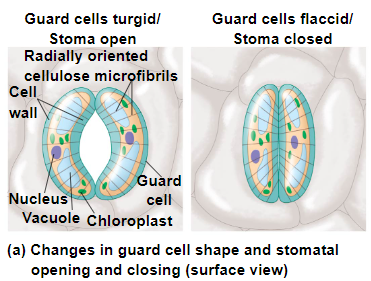
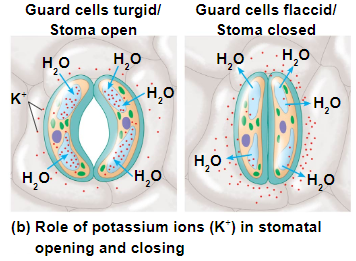 (True) - Changes in turgor pressure result primarily from the reversible uptake and loss of potassium ions by the guard cells.
(True) - Changes in turgor pressure result primarily from the reversible uptake and loss of potassium ions by the guard cells.
Protein Pumps - These pumps generate the membrane potential required to move K+ across the plasma membrane.
Stimuli for Stomatal Opening and Closing
(True) - Generally, stomata opens during the day and closes at night to minimize water loss.
Light, CO2 Depletion, Internal Clock of Guard Cells - Factors that trigger stomatal opening at dawn:
Circadian Rhythms - This is the internal clock for all eukaryotic organisms. It has a 24-hour cycle.
(True) - Drought Stress can cause stomata to close during the day.
Abscisic Acid (ABA) - It is the hormone produced in response to water deficiency and causes the closure stomata.
Effects of Transpiration on Wilting and Leaf Temperature
(True) - Sunny, warm, dry, or windy conditions cause evaporation and increase transpiration the rates.
(True) - Some evaporative water loss occurs through the cuticle when stomata are closed.
Wilting - What happens to the plant if uptake and transport aren’t sufficient to replace the lost water?
Evaporative Cooling - Transpiration also results in this, which can lower the temperature of a leaf.
Adaptations that Reduce Evaporative Water Loss
Xerophytes - These are plants that adapted to arid climates.
(True) - Some desert plants complete their life cycle during the rainy season. Others have fleshy stems that store water/leaf modifications that reduce the rate of transpiration.
Crassulacean Acid Metabolism (CAM) - It is a specialized form of photosynthesis in which stomatal gas exchange occurs at night.
(True) - Photosynthesis : Exchange of gases
Concept 36.5: Sugars are Transported from Sources to Sinks via the Phloem
Translocation - It is the transportation of photosynthetic products through the phloem.
Movement from Sugar Sources to Sugar Sinks
Sieve-Tube Elements - These are the conduits for translocation in angiosperms.
Phloem Sap - An aqueous solution that is high in sucrose. It travels from a sugar source to a sugar sink.
Sugar Source - An organ that is a net producer of sugar, such as mature leaves.
Sugar Sink - An organ that is a net consumer or depository of sugar, such as roots, buds, and fruits.
(True) - A storage organ can be a sugar sink in the summer and sugar source in spring.
(True) - Sugar must be loaded into sieve-tube elements first before being exported to sinks.
(True) - Depending on the species, sugar may move by symplastic or both symplastic and apoplastic pathways.
Companion Cells - These cells enhance solute movement between the apoplast and symplast.
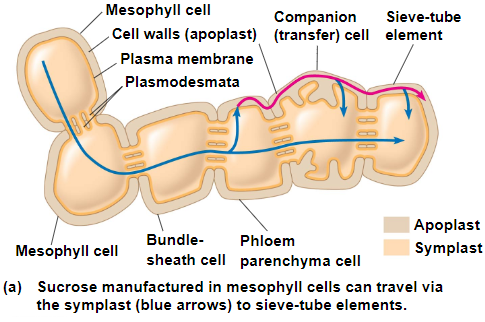 (True) - In many plants, phloem loading requires active transport.
(True) - In many plants, phloem loading requires active transport.
Sucrose - Proton pumping and cotransport of sucrose and H+ enables the cells to accumulate, what?
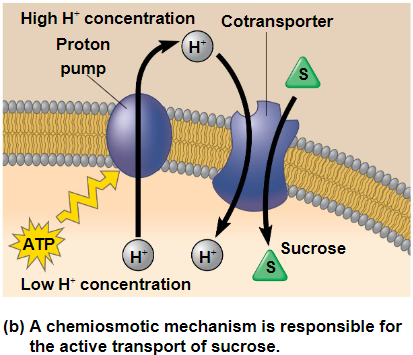 (True) - At the sink, sugar molecules diffuse from the phloem to sink tissues and are followed by water.
(True) - At the sink, sugar molecules diffuse from the phloem to sink tissues and are followed by water.
Bulk Flow by Positive Pressure: The Mechanism of Translocation in Angiosperms
Pressure Flow - A positive pressure that drives the bulk flow of Phloem sap moving through a sieve tube.
(True) - Phloem saps flows from sources, where pressure is high, to sinks, where pressure is low.
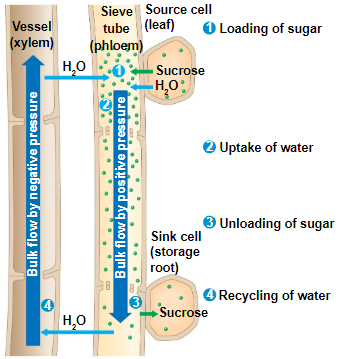 Self Thinning - It is the dropping of sugar sinks when there are more sugar sinks than the sources can support.
Self Thinning - It is the dropping of sugar sinks when there are more sugar sinks than the sources can support.
Flowers, Seeds, Fruits - Examples of sugar sinks.
Concept 36.6: The Symplast is Highly Dynamic
Symplast - It is a living tissue that is responsible for dynamic changes in plant transport processes.
Changes in Plasmodesmatal Number and Pore Size
(True) - Plasmodesmata can open or close in response to turgor pressure, Cytosolic Ca2+ Levels, or Cytosolic pH.
(True) - Plant viruses can cause plasmodesmata to dilate, allowing vial RNA to pass between cells.
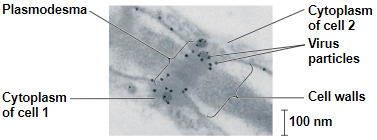 Phloem: An Information Superhighway
Phloem: An Information Superhighway
Phloem - It is the “superhighway” for systemic transport of macromolecules and viruses.
Systemic Communication - Communication throughout the phloem that helps integrate functions of the whole plant.
Electrical Signaling in the Phloem
(True) - The phloem allows for rapid electrical communication between widely separated organs. Example, it transports electrical signals in rapid leaf movements in the sensitive plant.